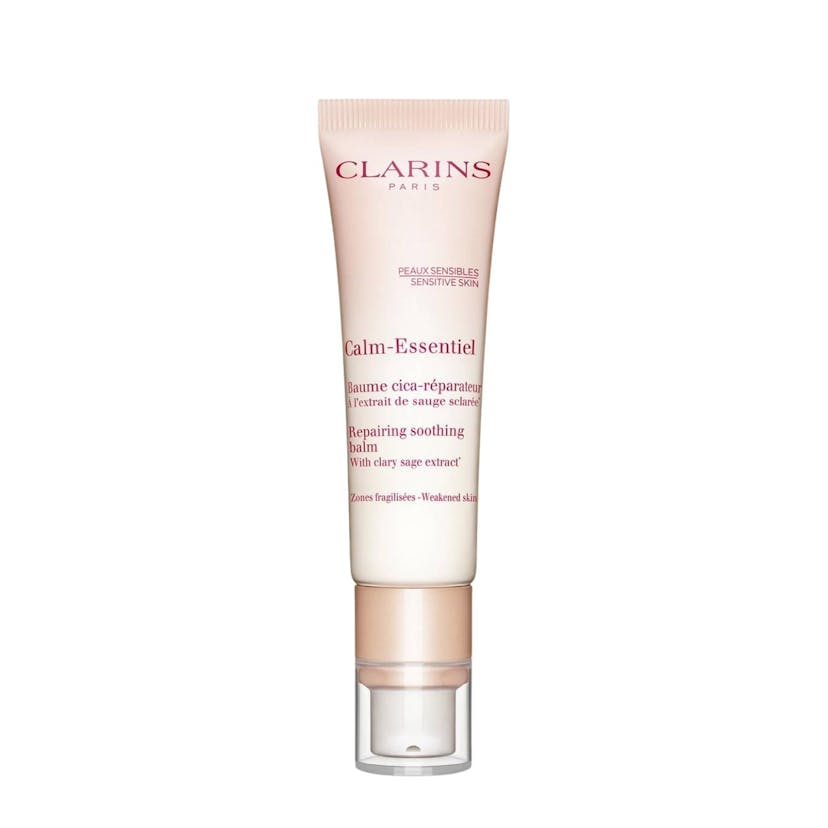Do You Have Rosacea? Here’s Your Treatment Plan
9 minutes read
“Nature’s own blusher” as it sometimes gets called, rosacea is something many of us have – particularly as we get older. If you’re looking for a dermatologist-approved rosacea treatment that can help treat your redness and bumps, then you’re in the right place.
Beauty Daily consulted with two leading experts, Dr Alia Ahmed, a leading dermatologist specialising in the psychological effects of rosacea, and Eli Brecher, a nutritionist and gut health specialist, about how to tackle the skin condition. From identifying symptoms and triggers to the best rosacea treatment and dietary solutions available, read on to discover more.

What is rosacea?
Does your skin get red when you step out of the shower or feel tight when you’re exposed to hot and freezing weather? Does it react after applying certain skincare products or eating spicy foods – and do you blush strongly when you feel emotional?
If you get constantly rosy cheeks, chances are you have rosacea. People who have rosacea can be prone to persistent blushing or flushing in the face. The chronic skin condition impacts 5% of the world’s population and is more prevalent among women than men.
“Rosacea is most commonly characterised by background inflammation (affecting the forehead, nose, cheeks, chin), some patients also experience spots or bumps in the centre portion of the face,” Dr Ahmed explains. “Ongoing inflammation can lead to facial oedema [facial swelling] and a feeling of dryness,” she adds. “Burning, stinging, and flushing are also reported by people with rosacea.”
The British Skin Foundation reports that rosacea predominantly affects fair-skinned people but may affect all skin types in people aged 40 to 60.
“Rosacea can be difficult to diagnose in the skin of colour (SOC) or deeply pigmented skin. The reason for this is the widely recognised symptoms of ‘flushing’ or ‘redness’ look different in pigmented skin,” explains Dr Ahmed.
For those of us with melanin-rich skin, rosacea will not look ‘red’ or ‘flushed’, but is more likely to look dusky or have a violet tone in deeply pigmented skin or appear to have yellow or brown bumps.
“Discolouration may develop in areas of inflammation,” notes Dr Ahmed. “If rosacea is diagnosed later or with more severe symptoms, there is a higher chance that there will be added issues like hyperpigmentation or changes to skin texture.”
What are the symptoms of rosacea?
Signs and symptoms of rosacea include:
- Sensitive skin (i.e., sensitive or reacts easily to skincare products)
- Feelings of burning, stinging or hot/warm skin
- Feelings of dryness or oiliness in the skin
- Pus-filled spots/pimples (acne-like breakouts)
- Skin can feel ‘swollen’ or ‘thick’ and it may differ in texture from unaffected areas
- Persistent facial redness
- Small blood vessels in the skin become visible.
Dr Ahmed adds, “One of the more severe presentations of rosacea is with ‘rhinophyma’ – this is where the skin around the nose thickens and can cause changes to its shape. While ocular rosacea can present with symptoms of itching, a burning or sore feeling, excessive tearing, or dry eyes, feeling of grit in the eyes, sensitivity to light and ulceration in severe cases.”
Emotional effects of rosacea
Rosacea can take its toll on those who have it, not least psychologically. Studies show people who suffer from rosacea can be associated with embarrassment, emotional distress, low self-esteem, and avoidance of social situations.
“Rosacea is a chronic condition with a large psychological impact,” Dr Ahmed notes. “Rosacea patients have an increased risk of developing depression and anxiety and tend to avoid socialising. Other reported problems include social anxiety disorder and body dysmorphia.”
She continues, “Psychological factors, such as stress and anxiety can aggravate flushing in rosacea, leading to a vicious circle. Patients report issues with lack of confidence, social isolation, and reduced quality of life.” Does this ring a bell? Read on to find out more about the causes and treatment of rosacea, to help with both the physical and psychological symptoms.
What causes rosacea?
The root causes of rosacea are not fully understood, but they can include immune dysregulation, neurovascular changes, microbial imbalance, and genetics (rosacea often runs in families).
“Rosacea is a female predominant condition; this may be due to female hormone imbalances acting as triggers. Triggers for rosacea are implicated in the pathophysiology (e.g., microbes, UV radiation, extremes of temperature, epidermal disruption, stress, and hormones),” says Dr Ahmed.
A study by the National Rosacea Society identified the following triggers: UV exposure (81%), emotional stress (79%), hot weather (75%), wind (57%), intense physical exercise (56%), alcohol consumption (52%), hot baths (51%). Other, less common triggers include chilly weather (46%), spicy foods (45%), humidity (44%), skincare products (41%), hot drinks (36%), cosmetics (27%), medicines (15%), and medical conditions (15%).
You can’t prevent yourself from suffering from rosacea but acting upon your triggers can make all the difference.
The immune systems of people with rosacea may also play a role in the symptoms. It is suggested that the immune systems of rosacea patients are more likely to react to stimuli that other people’s bodies could ignore. For example, an enhanced reactivity to the demodex mite [a microscopic mite that can only survive on the skin of humans].
What to do if you think you have rosacea
It is best to see a specialised medical practitioner like Dr Ahmed or your GP if you have persistent symptoms that could be caused by rosacea. The NHS says early diagnosis and treatment can help stop the condition from getting worse.
Best rosacea treatments to try
There is a plethora of rosacea treatments to help ease its symptoms. The management of rosacea is complex – usually a combination of medical, skincare, lifestyle, and psychological management. From in-clinic lasers, and creams, to dietary and lifestyle changes, Dr Ahmed recommends topical rosacea treatments, such as antibiotic creams and antiparasitic creams to act against a commonly occurring mite on the skin (thought to cause or aggravate symptoms) and reduce inflammation. Products with azelaic acid are also effective at reducing redness and inflammation, while oral antibiotics can be used at low doses as an anti-inflammatory. Topical retinoids can also be used with caution as anti-inflammatories for the treatment of rosacea.
Rosacea in-clinic laser treatment
“If the above treatments do not lead to improvement, low dose oral retinoids are a long-term option, as well as light-based therapies (e.g., pulsed dye laser or intense pulsed light) or laser,” says Dr Ahmed.
Rosacea skincare routine
The best rosacea skincare regimen should do two things: calm and camouflage inflamed skin.
The routine typically includes gentle cleansers to wash the face, mineral sunscreen, and light moisturisers.
Charlotte McHale, Clarins Training Manager, recommends starting your beauty routine with a Soothing Gentle Foaming Cleanser and exfoliating once or twice a week with Comfort Scrub. This should be followed by targeted treatments from the Calm-Essentiel Range. “It is tailored for people with weakened and compromised skin like rosacea. Calm-Essential Redness Corrective Gel is best for calming and cooling red flare-ups.”
You can use the corrective gel in the morning, as this can soothe inflamed skin and be used as an excellent primer thanks to the greenish gel that counteracts the crimson on the skin.
Having rosacea can make skin feel dry, which leads some people to over-moisturise and aggravate inflammation. Dr Ahmed advises people with rosacea to pick fragrance-free and non-comedogenic formulas. Supporting the skin barrier is important too – look for serums and light creams with hydrating qualities.
Dr Ahmed says: “Consider adding in Vitamin C and Azelaic acid to your skincare regime. Skin with rosacea can be sensitive or irritated easily, therefore introduce products slowly over time. Avoid highly fragranced products as they can cause skin reactions and aggravate rosacea.”
She adds, “I see many patients with rosacea, their treatment is usually on a spectrum ranging from no treatment to skincare only, to skincare + medical treatment, to medical treatment only. The type of rosacea and associated symptoms will typically dictate the treatment options.”

Beauty Daily recommends the fragrance-free and non-greasy Calm-Essentiel Soothing Repairing Balm which can be used on the face and body. It immediately soothes, repairs, and nourishes the skin and it is formulated with more than 95% natural ingredients for maximum tolerance and effectiveness. Use daily to see the best results.
The key plant active ingredient in the range is clary sage extract, which Clarins Laboratories, in collaboration with research institutes, has clinically proven to reduce skin sensitivity to irritants. In addition, vegetable squalene reinforces and protects the skin. Both soothe, repair, and hydrate sensitive skin, increasing its tolerance.
Use of moisturisers and UV protection showed beneficial effects for rosacea. So, make sure to never skip applying SPF during AM.
Rosacea diet plan
Certain foods can trigger or exacerbate rosacea symptoms. Registered Associate Nutritionist Eli Brecher (ANutr) says common dietary triggers include spicy food, such as hot sauce and cayenne pepper, and hot beverages, such as coffee and tea.
“Tomatoes, citrus fruit, cinnamon and chocolate are also common triggers, and while these four foods may not appear to have much in common, they all contain a compound called cinnamaldehyde, which is thought to be the trigger.”
And you might want to cut back on the merlot and cabernet sauvignon. The National Rosacea Society found that certain types of alcohol trigger rosacea more than others. 76% of respondents reported that red wine worsened their skin condition. Yikes!
A food diary can help keep a record of any meals that trigger and eliminate them from your diet accordingly. Make sure to do this under the guidance of a healthcare professional to avoid any nutritional deficiencies.
A survey found that 78% of participants who made changes to their diet due to rosacea, experienced 95% reduction in flare-ups because of dietary changes.
“Rosacea has been linked to an imbalance in the gut microbiome, so focus on supporting your gut health by including plenty of fibre-rich fruit, vegetables, beans, nuts, seeds and legumes such as lentils,” advises Brecher.
“Another way to support your gut health, and in turn your skin health, is with probiotic and prebiotic foods. Prebiotics are dietary fibre that feeds the gut microbiome. Probiotics are live bacteria that can be found in certain foods or consumed in the form of supplements. Prebiotics include garlic, onion, leeks, asparagus, and slightly under-ripe bananas, while probiotics are found in fermented foods, such as live yoghurt, kefir, sauerkraut, and kimchi,” she concludes.
Read next: What is a microbiome?
Another step you could do to treat rosacea is to manage stress. “Stress is also thought to play a role in causing or worsening facial flushing through the sympathetic nervous system response (i.e., preparing the body for ‘fight or flight’),” says Dr Ahmed. So de-stressing is key. Need some tips? Read our six expert-backed ways to manage and reduce stress.
Did you know that rosacea is one of the seven most common skin conditions dermatologists see? Check the other six here and how to treat them.
We hope you’ve found the above guide useful. Remember that you’re not alone and that there are plenty of ways to manage and treat rosacea.
For more advice on getting emotional support for rosacea and other skin disorders, visit skinsupport.org.uk. The British Skin Foundation also is a great resource for those struggling with their skin, as is the British Association of Dermatologists (BAD) and Changing Faces, both of which offer advice and support from qualified professionals.
Sign up for our newsletter
We will keep you in the loop for special offers, exclusive gifts and product news.

